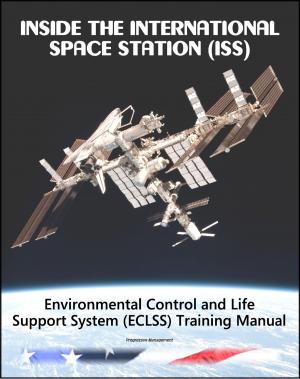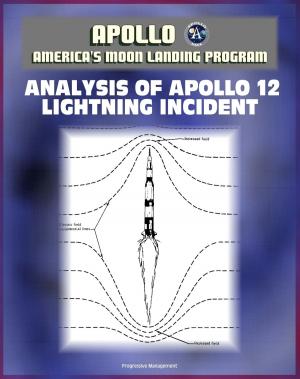Apollo-Soyuz Test Project (ASTP) American and Soviet Press Kits - Detailed Information on the First Joint U.S. and Russian Spaceflight, Docking Module, Experiments, Soyuz Capsule
Nonfiction, Science & Nature, Technology, Aeronautics & Astronautics, Science, Physics, Astrophysics & Space Science| Author: | Progressive Management | ISBN: | 9781476175034 |
| Publisher: | Progressive Management | Publication: | May 11, 2012 |
| Imprint: | Smashwords Edition | Language: | English |
| Author: | Progressive Management |
| ISBN: | 9781476175034 |
| Publisher: | Progressive Management |
| Publication: | May 11, 2012 |
| Imprint: | Smashwords Edition |
| Language: | English |
These American and Soviet Press Kits for the historic 1975 Apollo-Soyuz Test Project (ASTP) mission provide a wealth of information about the mission and the spacecraft - including the first extensive official description of the Soyuz capsule.
The introduction states: This document contains information about the Apollo Soyuz Test Project and consists of two parts prepared by the U.S. and the U.S.S.R. respectively. Each part contains information on the goals and on the program of the mission, features and characteristics of the spaceships, a flight plan and joint and unilateral experiments. Brief biographies of the astronauts and cosmonauts involved in the flight, a description of technical support activities, also a description of the flight management personnel of each side are included. The Soviet and American parts have been prepared individually.
The release previewed the on-time and successful mission:
Two manned spacecraft will be launched into Earth orbit July 15 — one from Merritt Island, Florida, and the other from Central Asia — to bring into reality the May 1972 agreement between the United States and the Soviet Union to work toward a common docking system for future generations of spacecraft.
The nine-day Apollo Soyuz Test Project mission will mark the first time that manned spacecraft of two nations have met in space for joint engineering and scientific investigations.
First to go into space will be the Soviet Union's Soyuz spacecraft with Commander Aleksey Leonov and Flight Engineer Valeriy Kubasov aboard, lifting off at 8:20 am Eastern Daylight Time July 15 from the Soviet Cosmodrome at Baykonur. Seven and a half hours later, at 3:50 pm Eastern Daylight Time, Apollo will lift off from Kennedy Space Center Launch Complex 39B with Commander Thomas P. Stafford, Command Module Pilot Vance Brand and Docking Module Pilot Donald K. Slayton aboard.
Control Centers in Houston and Moscow will exercise joint ground control over the mission through exchange of communications and tracking data as a further means of fulfilling the agreement on space cooperation.
Communications between the Apollo spacecraft and Mission Control-Houston and between the docked Apollo Soyuz spacecraft and both control centers will be enhanced by use of a communications satellite for real-time relay of voice, data and television signals. Applications Technology Satellite 6 (ATS-6), in synchronous orbit 35,900 km (22,260 mi.) above Kenya, will provide communications coverage for 55 percent of each Apollo and docked Apollo Soyuz orbit through Apollo's steerable high-gain antenna. This will be the first time a satellite is used to relay communications between an orbiting manned spacecraft and ground stations. Both live and recorded color television will be relayed from Apollo to keep flight control teams and the general public informed on mission activities.
These American and Soviet Press Kits for the historic 1975 Apollo-Soyuz Test Project (ASTP) mission provide a wealth of information about the mission and the spacecraft - including the first extensive official description of the Soyuz capsule.
The introduction states: This document contains information about the Apollo Soyuz Test Project and consists of two parts prepared by the U.S. and the U.S.S.R. respectively. Each part contains information on the goals and on the program of the mission, features and characteristics of the spaceships, a flight plan and joint and unilateral experiments. Brief biographies of the astronauts and cosmonauts involved in the flight, a description of technical support activities, also a description of the flight management personnel of each side are included. The Soviet and American parts have been prepared individually.
The release previewed the on-time and successful mission:
Two manned spacecraft will be launched into Earth orbit July 15 — one from Merritt Island, Florida, and the other from Central Asia — to bring into reality the May 1972 agreement between the United States and the Soviet Union to work toward a common docking system for future generations of spacecraft.
The nine-day Apollo Soyuz Test Project mission will mark the first time that manned spacecraft of two nations have met in space for joint engineering and scientific investigations.
First to go into space will be the Soviet Union's Soyuz spacecraft with Commander Aleksey Leonov and Flight Engineer Valeriy Kubasov aboard, lifting off at 8:20 am Eastern Daylight Time July 15 from the Soviet Cosmodrome at Baykonur. Seven and a half hours later, at 3:50 pm Eastern Daylight Time, Apollo will lift off from Kennedy Space Center Launch Complex 39B with Commander Thomas P. Stafford, Command Module Pilot Vance Brand and Docking Module Pilot Donald K. Slayton aboard.
Control Centers in Houston and Moscow will exercise joint ground control over the mission through exchange of communications and tracking data as a further means of fulfilling the agreement on space cooperation.
Communications between the Apollo spacecraft and Mission Control-Houston and between the docked Apollo Soyuz spacecraft and both control centers will be enhanced by use of a communications satellite for real-time relay of voice, data and television signals. Applications Technology Satellite 6 (ATS-6), in synchronous orbit 35,900 km (22,260 mi.) above Kenya, will provide communications coverage for 55 percent of each Apollo and docked Apollo Soyuz orbit through Apollo's steerable high-gain antenna. This will be the first time a satellite is used to relay communications between an orbiting manned spacecraft and ground stations. Both live and recorded color television will be relayed from Apollo to keep flight control teams and the general public informed on mission activities.















